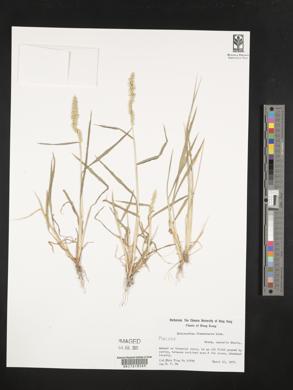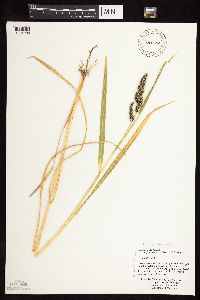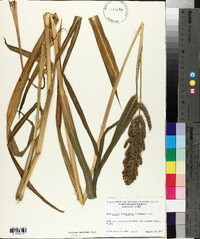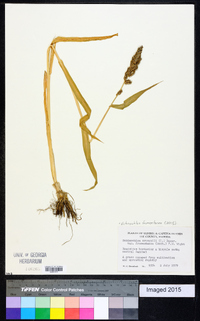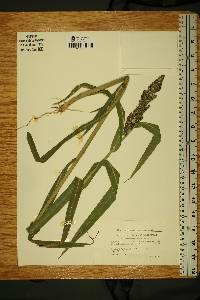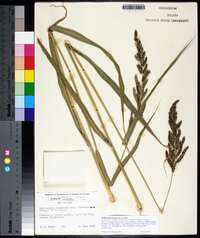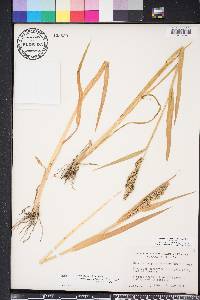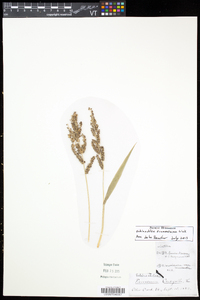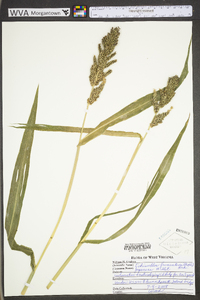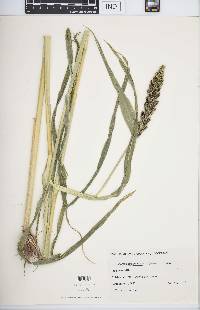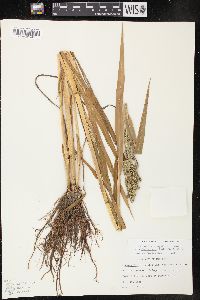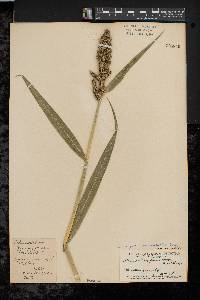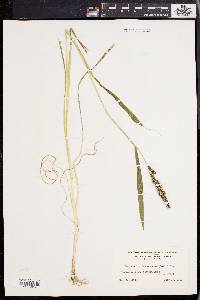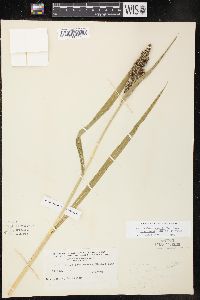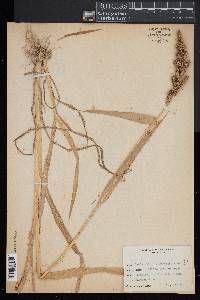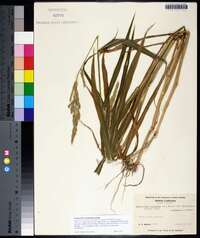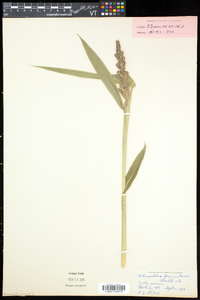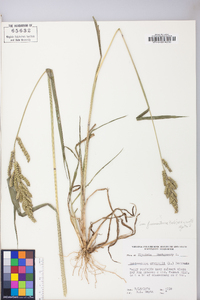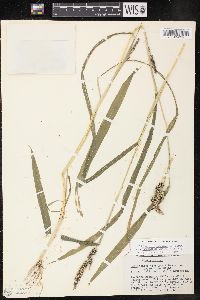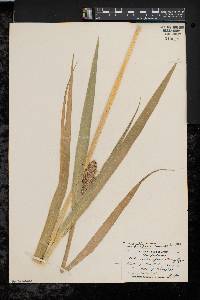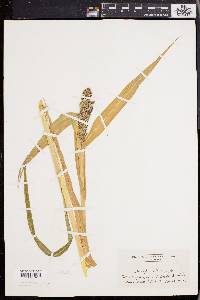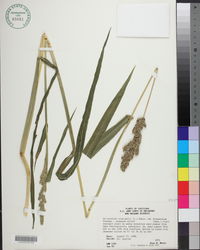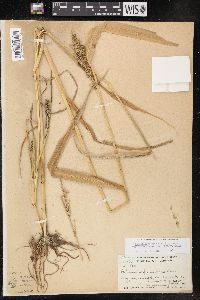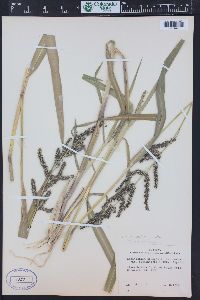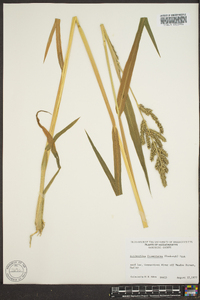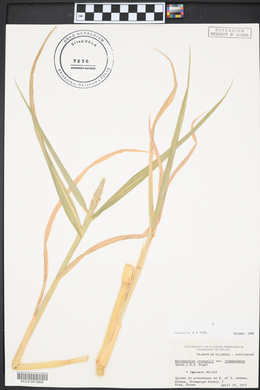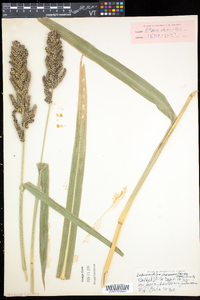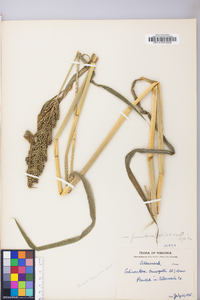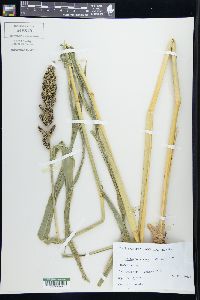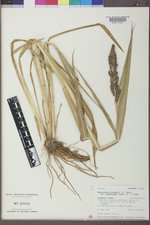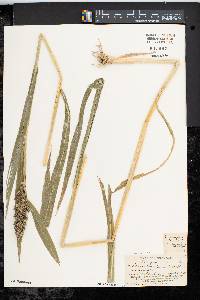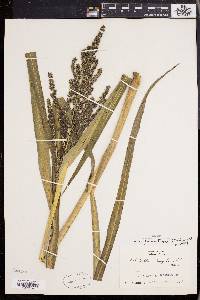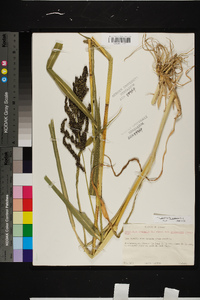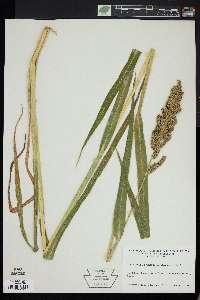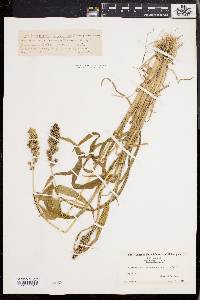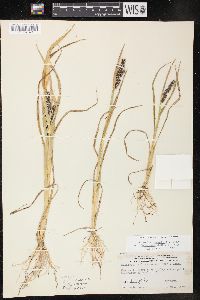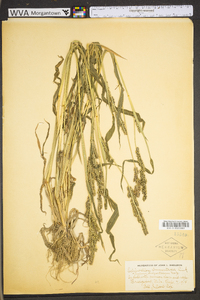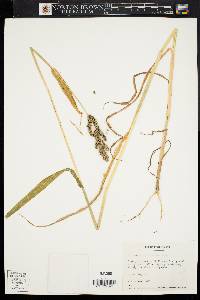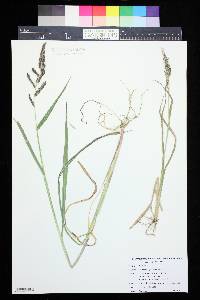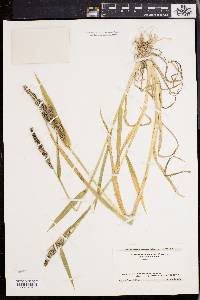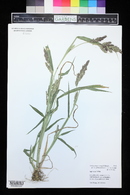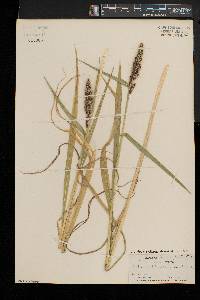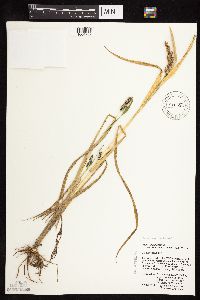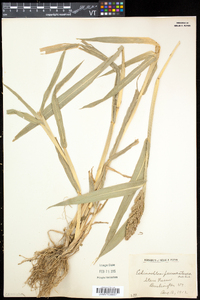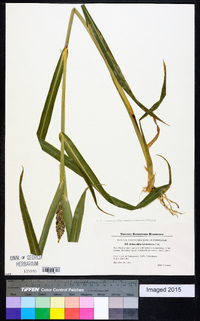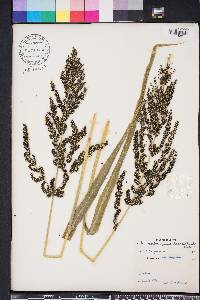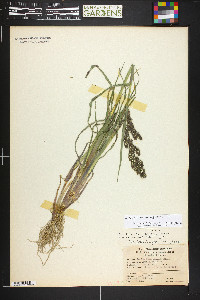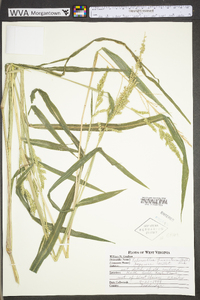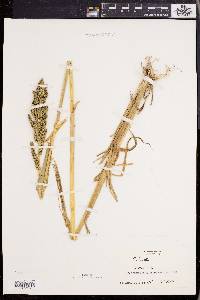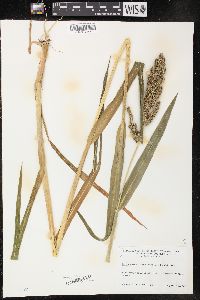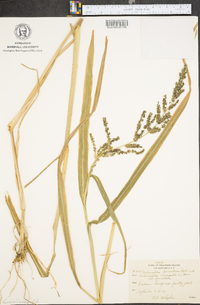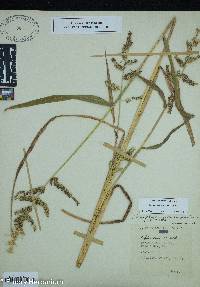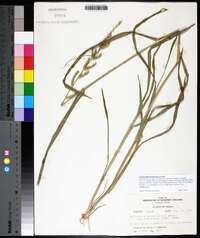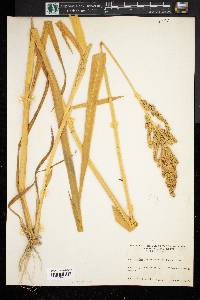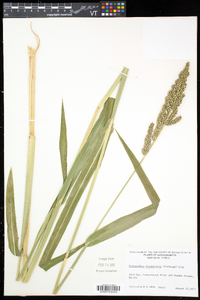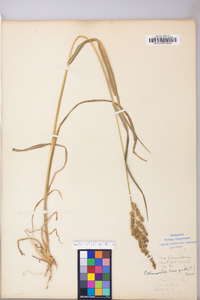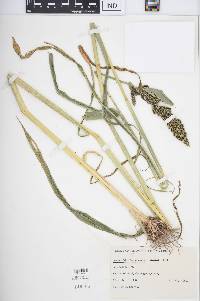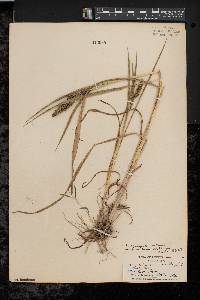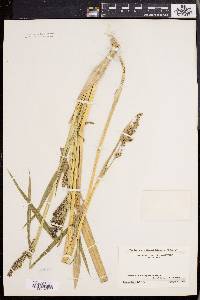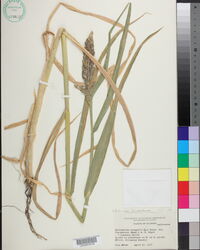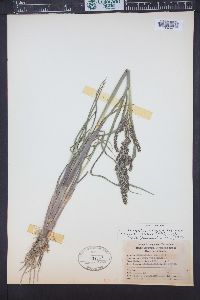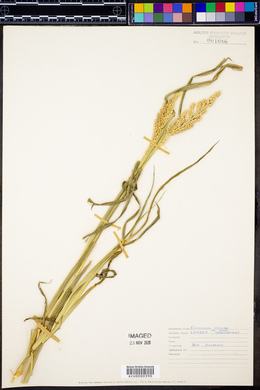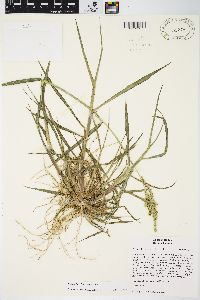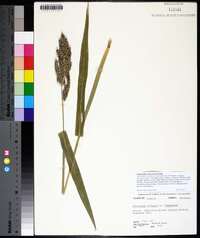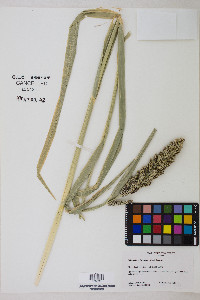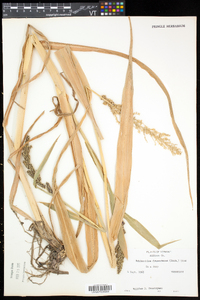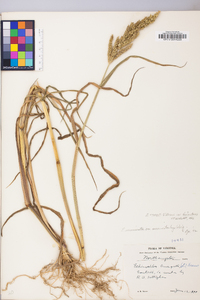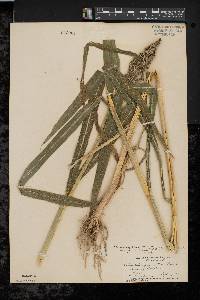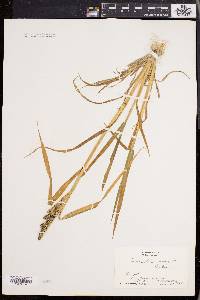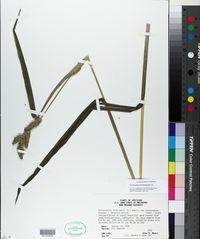
|
|
|
|
Family: Poaceae
Japanese-Millet, more...Siberian Millet, White Panic
[Echinochloa colona var. frumentacea (Roxb.) Ridl., moreEchinochloa crus-galli var. edulis Honda, Echinochloa crusgalli var. edulis Hitchc., Echinochloa crusgalli var. frumentacea , Oplismenus frumentaceus (Roxb.) Kunth, Panicum crus-galli var. edule (Hitchc.) Thell. ex de Lesd., Panicum crus-galli var. edulis (Hitchc.) Makino & Nemoto, Panicum crus-galli var. frumentaceum (Roxb.) Trimen, Panicum frumentaceum Roxb.] |
Plants annual. Culms 70-150 cm, erect, glabrous. Sheaths glabrous; ligules absent; blades 8-35 cm long, 3-20(30) mm wide, glabrous. Panicles 7-18 cm, erect to slightly drooping at maturity, rachises not or only sparsely hispid, nodes with papillose-based hairs; branches numerous, appressed or ascending, spikelike, not or only sparsely hispid, hairs papillose-based; primary branches 1.5-4 cm, glabrous or sparsely hispid, hairs to 3 mm, papillose-based; secondary branches, if present, usually concealed by the densely packed spikelets; longer pedicels 0.2-0.5 mm. Spikelets 3-3.5 mm, often with 1 sterile and 2 bisexual florets, not disarticulating at maturity (particularly those near the bases of the panicles), scabrous or short-hispid but without papillose-based hairs, green and pale at maturity, apices usually obtuse, varying to acute. Upper glumes narrower and shorter than the upper lemmas; lower florets sterile; lower lemmas unawned; lower paleas subequal to the lower lemmas; upper lemmas 2.5-3 mm, ovate to elliptic, coriaceous portion terminating abruptly at the base of the membranous tip; anthers 0.8-1 mm. Caryopses 1.7-2.2 mm long, 1.6-1.8 mm wide, whitish; embryos 66-86% as long as the caryopses. 2n = 36 [J.D. Munshi, J.K. Pal, V. Bansikar, and N. Pandit. 1994. Eco-cytological studies of Echinochloa frumentacea (Roxb.) Link of Diara Lands of Bhagalpur, Bihar. Proc. Indian Sci, Congr. 81:112], 54. Echinochloa frumentacea originated in India, and possibly also in Africa. It is grown for grain, fodder, and beer, although not as extensively as in the past. It is found occasionally in the contiguous United States and southern Canada, the primary source being birdseed mixes. It used to be confused with E. esculenta, from which it differs in its whitish caryopses and proportionately smaller embryos. Hybrids between E. frumentacea and E. colona are partially fertile; those with E. esculenta are sterile. Annual herb 0.7 - 1.5 m tall Leaves: alternate, two-ranked. Sheaths open, compressed. Ligules absent. Blades 8 - 35 cm long, 3 mm - 2 cm wide, usually over ten times longer than wide, linear to lance-shaped, flat, parallel-veined, with a prominent midrib. Inflorescence: a terminal arrangement of spikelets (panicle), upright or slightly nodding, 7 - 18 cm long, with an elongate and sometimes sparsely hairy axis. Branches many, ascending or appressed, spike-like, sometimes with a few bumpy-based hairs. Primary branches 1.5 - 4 cm long. Secondary branches (if present) hidden by the spikelets. Fruit: a caryopsis, indehiscent, enclosed within the persistent lemma and palea, whitish, 1.5 - 2 mm long, 1.5 - 2 mm wide. Culm: upright, 0.7 - 1.5 m long, round in cross-section. Spikelets: densely crowded on angular branches, pale green at maturity, 3 - 3.5 mm long, flat on one side and convex on the other (plano-convex), usually rounded at the apex, rough or shortly hairy, often with two bisexual florets and one sterile floret. Florets: two per spikelet. Lower florets sterile. Upper florets bisexual, compressed dorsally. Anthers three to 1 mm long. Stigmas red. Glumes:: Lower glumes membranous. Upper glumes shorter and narrower than upper lemmas, membranous. Lemmas:: Lower lemmas similar to upper glumes in texture and size. Upper lemmas 2.5 - 3 mm long, egg-shaped to elliptic, rounded dorsally, leather-like. Paleas:: Lower paleas nearly equal to the lower lemmas. Similar species: No information at this time. Flowering: August to October Habitat and ecology: Introduced from Asia, and occasionally escaping from cultivation. Occurence in the Chicago region: non-native Etymology: Echinochloa comes from the Greek words echinos, meaning hedgehog, and chloa, meaning grass, referring to the bristly spikelets of some species. Frumentacea means grain-bearing. Author: The Morton Arboretum Panicle-branches appressed or only slightly spreading, densely fld, with closely crowded, plump, awnless or only shortly awn-tipped, usually grayish-purple spikelets; plants relatively large and coarse, 7-15 dm, the lvs mostly 15-30 mm wide. (E. frumentacea) Cultigen from se. Asia, occasionally cult. with us for forage, sometimes escaped, but not persistent. Gleason, Henry A. & Cronquist, Arthur J. 1991. Manual of vascular plants of northeastern United States and adjacent Canada. lxxv + 910 pp. ©The New York Botanical Garden. All rights reserved. Used by permission. |


